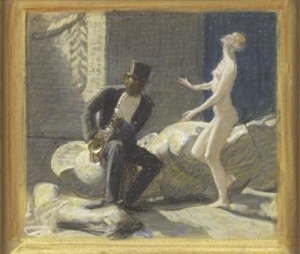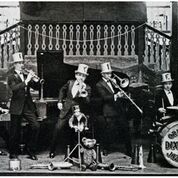
Rhythm and Reaction: the subversive influence of jazz
Sanjiv Sachdev reviews an exhibition focusing on the influential, dangerous and subversive power of jazz.
It is nearly a century since live Jazz came to Britain. Playing at the London Hippodrome in April 1919, the Original Dixieland Jazz Band first brought the music to these Isles, followed soon after by the all black Southern Syncopated Orchestra (whose members included Sidney Bechet) to venues such as the Hammersmith Palais de Danse, Glasgow’s Kelvin Hall and London’s Café de Paris. So arrived what Eric Hobsbawn (historian and jazz critic) called ‘one of the most significant phenomena of twentieth-century world culture’.

The Original Dixieland Jazz Band at The Palais de Dance, Hammersmith, 1919. Photograph © Max Jones Archive
The neo-Gothic delight Two Temple Place, near Thames Embankment, is a marvellous building. Once owned by the US robber-baron Astor family, it is now devoted to educational and artistic work and has for the last seven years softened the hard edges of winter, with its free exhibitions. ‘Rhythm and Reaction’ is small, tantalising, wide-ranging show that offers glimpses of how illicit, wild and dangerous Jazz was sometimes seen to be, how it challenged conceptions of race, reshaped music, altered design, embraced new technology (vinyl LPs and gramophones), inspired dance, influenced art and even threatened imperial sensibilities.

Perhaps the most poignant tale concerns ‘The Breakdown’ (1926) a painting by J.B. Souter. A black, male saxophonist, attired in evening dress, plays while sitting on a broken classical statue while a naked white woman dances nearby. Shown at the Royal Academy’s Summer exhibition it was initially praised by the Academy’s president as ‘a work of great promise…executed with a considerable degree of excellence’ but was taken down after just five days, after intervention from the Colonial Office, as it was, according to the Royal Academy Annual Report ‘considered to be obnoxious to British subjects living abroad in daily contact with a coloured population’. The music magazine, ‘Melody Maker’ denounced that paintings association ‘with the primitive and barbarous negro derivation [of Jazz]’ and called for it to be burnt. The artist subsequently destroyed the work - only sketches for the original and a much later new version survive - all on show at the exhibition.
Edward Burra’s work in the Harlem scene; the police photos of Sidney Bechet who, after being arrested in Clerkenwell, was sentenced to hard labour for two weeks before being deported to the United States; cartoons expressing conflict between miners and coal mine owners using the metaphor of jazz; bright London Underground posters advertising the nighttime delights of London; modernist dance outfits; fractured, Cubist inflected paintings; jazzy ceramics and much more wait to be seen. A good way to welcome Spring!
‘Rhythm & Reaction: The Age of Jazz in Britain’ until 22nd April 2018 at Two Temple Place, London, WC2R 3BD (closed on Tuesdays). Free.
